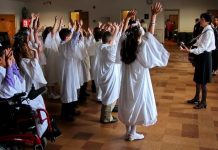
by Mary Ann Garfold
As we firm up our ideas for Vacation Bible School, we might look forward to the new year of faith formation that will begin in the fall and ask ourselves how we can continue the summer-time enthusiasm that our parish shares in anticipation of Vacation Bible School, parish festivals, and parish picnics. Can we recreate any of that excitement, anticipation, and sense of community in our parish religious education programs and classrooms?
Three Factors
In looking at our summertime activities, we discover three factors that contributed to the overall spiritual nourishment and success of those activities.
1. A sense of anticipation: As summer events draw near, we experience weekly messages in the parish bulletin, posters advertising the event, sign-up sheets for volunteers, personal invitations, phone calls, and a general sense throughout the parish that something exciting is going to happen and you don’t want to miss it.
Do we approach our religious education program in the same way? Do we display colorful posters about the program? Do we email families about the opportunities to participate? Do we offer sign-up tables for new families? Do we advertise in the local newspaper or send postcards/emails to students? Do catechists have a way of letting families know the theme for the year and that they cannot wait for the children to be a part of it? I send a letter of welcome to each child in my class at the beginning of the learning year, and I send updates each month.
2. An attention grabber: An exciting parish-wide event often presents a focused activity or character: an “attention grabber.” We usually do this through sights, smells, and sounds. We can do the same thing in our religious education classroom.
I often begin the first class of the year with a suitcase. I use one large suitcase and several pictures of suitcases. I let students know the theme for the year and where we are going and who we will meet along the way. On pieces of paper I list things we might take with us (Bibles, prayer cards, friends, baptismal garments, other special clothing, prayer intentions, notebooks, journals, study guides, cameras, etc.), and I ask each child to “pack” his/her suitcase. I dress as a travel guide and we begin our year-long journey together. Each class, I may dress up with the theme for the session or begin the session with an attention-grabber activity or relevant DVD.
3. An atmosphere of community: Our summer activities create a sense of community and belonging. Do we provide a sense of community and belonging in each session throughout the learning year?
One activity that creates this is the “spider web,” where a ball of yarn is passed randomly from one person to another in a circle (as the ball unravels). When holding the ball of yarn, the student tells something about himself or herself.
Another way to create community in our classroom is to invite our parish community into our sessions to share the learning experience. We can invite the Knights of Columbus, the Ladies of Charity, the Rosary Group, etc. We also have the opportunity to create community through intercessory prayer. We can include families in our prayer experience by inviting them to send us their intentions or by coming to pray with us in person. We create community through small-group activities and group discussions.
Finally, we create memories from our time together. We do this by giving opportunities for silence as well as sharing. We can keep a diary of our journey. We can take pictures. (I have given disposable cameras to students so they could take take pictures of faith-related things during the learning year.) We can create postcards to send to those who are not a part of our traveling community, and we obtain souvenirs (i.e., craft projects) along the way. Whatever we do, we should be able to “tell the story” of our faith journey and thus live our faith in the love of God and share it with one another.
Mary Ann Garfold has served as a school psychologist, retreat director, and director of RCIA. She is a master catechist in the Diocese of Wheeling-Charleston, WV.
Copyright 2013, Bayard, Inc. All rights reserved. This article is protected by United States copyright and other intellectual property laws and may not be reproduced, rewritten, distributed, redisseminated, transmitted, displayed, published or broadcast, directly or indirectly, in any medium without the prior written permission of Bayard, Inc.
This article was written by the Catechist Staff and appeared in Catechist magazine, July 2013.




